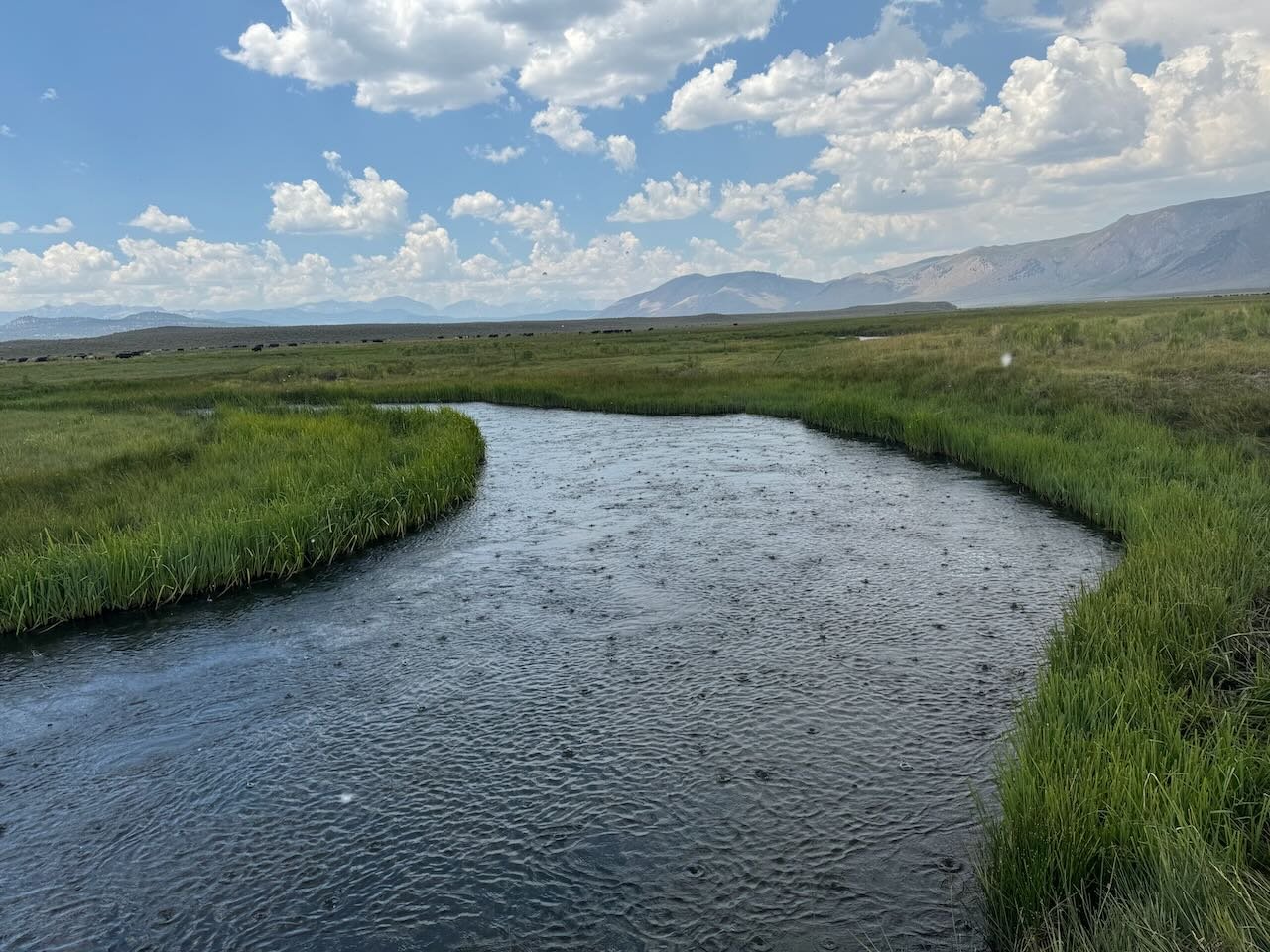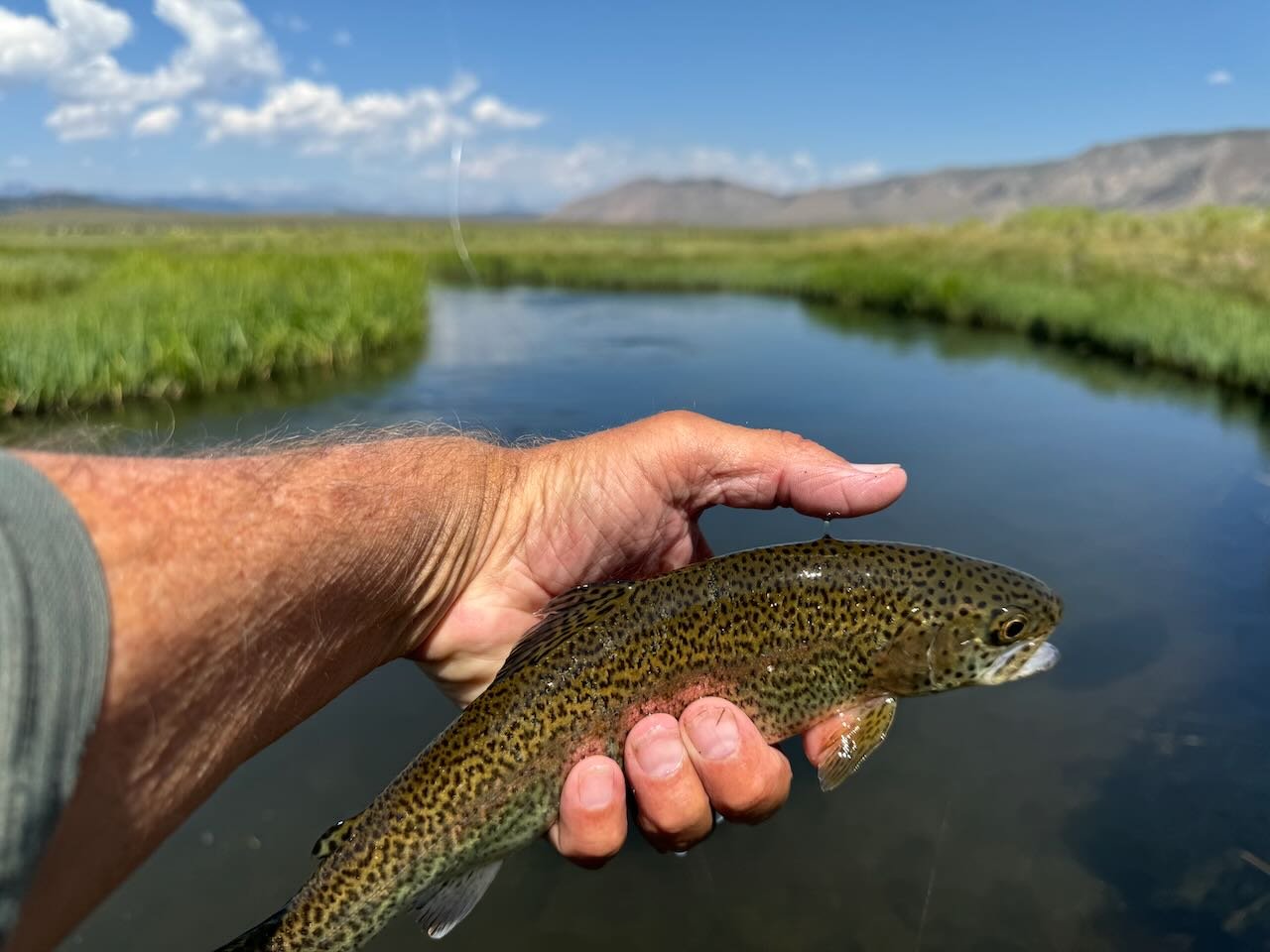The Eastern Sierra has been in a pattern of warm windless mornings and afternoon winds with summer rain showers. Hatches of mayflies, stoneflies, caddis and midges are bringing the trout to the surface. The sight of a trout rising from the bottom of the stream to take the dry fly you have gently presented to the surface is one of the most prized fly fishing experiences in the Eastern Sierra. Grass hoppers are turning from larvae to adults and are beginning to fly around and land on the water in the afternoon winds. The grass hopper hatch is the biggest insect hatch in the Eastern Sierra and is known to bring trophy trout to the surface. Sierra Bright Dot Guides have available dates in August and we are booking for fall.
Afternoon rain showers are cooling off the fly fishers and sweeping terrestrial insects off the banks into the rivers and streams of the Eastern Sierra.
Hot Creek
Interpretive Site:
Hot Creek is a selectively feeding trout water that is known for its dry fly fishing. Summer time is the peak of dry fly fishing on Hot Creek when hatches of mayflies and caddis flies have the trout feeding on the surface. The morning starts early, but not first light early, with a trico hatch that lasts tell 10:00 A.M. at the latest. It’s followed by a blue wing olive mayfly hatch. It ends in early afternoon with a gray caddis hatch. There is good evening caddis activity for those anglers fishing at dusk. For dry flies use size 22 trico parachutes, size 22 trico spinners, size 20 blue wing olive parachutes, size 20 olive sparkle duns, size 20 gray elk hair caddis and size 20 parachute caddis.
Not often you can find a section of Hot Creek Canyon with no fly fishers to compete against.
Hot Creek
Canyon Section:
A lot of fly fishers find the weed beds of Hot Creek Canyon hard to fish over or around. The key to success is to work the tiny lanes between the weed beds getting a drag free drift. There are a few pockets worth fly fishing. A dry fly can be worked down the tiny channels between the weed beds. When fishing with size 20 or smaller flies use a bigger dry fly as an indicator like a size 16 Adams parachute. This technique is known as a dry and dry rig. Use size 20 gray elk hair caddis, size 20 parachute caddis, size 20 blue wing olive parachutes, size 20 olive sparkle duns, size 22 trico parachutes and size 22 trico spinners.
Stormy afternoons on Crowley Lake means wind driven waves which makes fly fishing from a boat or float tube tough.
Crowley Lake
Mouth of McGee:
The flotilla of boats is centered around the flats where McGee Creek enters the lake. Midging in 10 feet of water with a tiger midge, zebra midge, blood midge, albino Barron and a gray midge suspended above the substrate is producing rainbows, browns and cutthroats. This is a spot that is now accessible to float tubers, kayaks and paddle boarders. Besides midging, working in and around the weed beds with callibaeties nymphs, damsel fly nymphs and olive wooly buggers stripped on a full sink line or a sink tip line is fooling the trout cruising the weed beds looking for an easy meal.
A typical upper Owens River rainbow trout that took a size 18 bead head flash back pheasant tail nymph fished six feet under an indicator.
Upper Owens River
Above Benton Crossing Bridge:
How do you like to fly fish? Dries, nymphs and streamers are producing rainbows and brown from three inches to 14 inches. For dry flies fish with size 16 or 18 Adams parachutes, size 18 blue wing olives, size 22 trico spinners, size 22 trico parachutes, size 16 pale morning dun parachutes, size 12 stimulators, size 16 elk hair caddis and your favorite hopper patterns in size 12 or 14. For nymphs fish with size 18 olive quilldigons, size 18 bead head flash back pheasant tail nymphs, size 16 hot spot pheasant tail nymphs, size 16 Prince nymphs and size 16 bead head flash back gold ribbed hare’s ears. A dry and dropper is producing fish with the nymph 18 to 36 inches below the dry fly on 5X fluorocarbon tippet. For those that love the response of bigger trout chasing down a fly, try fishing with size 6 or size 10 black wooly buggers, black matukas, black balanced leeches, black marabou muddlers and black slump busters. There are good hatches starting early in the morning and going through dusk. Any time you can get onto the river you will be able to fool the trout. Starting to see some hopper activity. So far not the epic hopper season I was expecting.
Bishop Creek Canal is flowing muddy and the banks are lined with the fresh dredging’s’ from the substrate.
Bishop Creek Canal
Behind Bishop Veterinary Hospital:
The Department of Water and Power for the City of Log Angles is dredging the canal. Where you can find clean water you can catch fish. Behind the veterinary hospital has been really dirty. When the cloud cover offers cooler day time temperatures fishing mid-day with dries and nymphs is producing trout. Broke out the Tenkara rod with a size 20 blue wing olive parachute and a size 16 Adams parachute. The Tenkara rod is designed to allow the dry fly fisher to finesse the dry flies on the surface. Eight to 12 inch wild browns offered lots of action on the dry flies. A dry and dropper rig would have smoked them, but I was having too much fun watching the trout rise to the surface to take the dry fly as it drifted over their lair.





